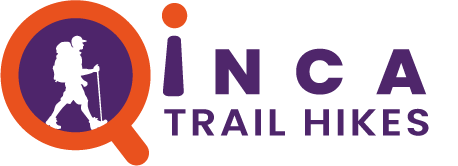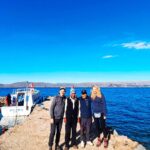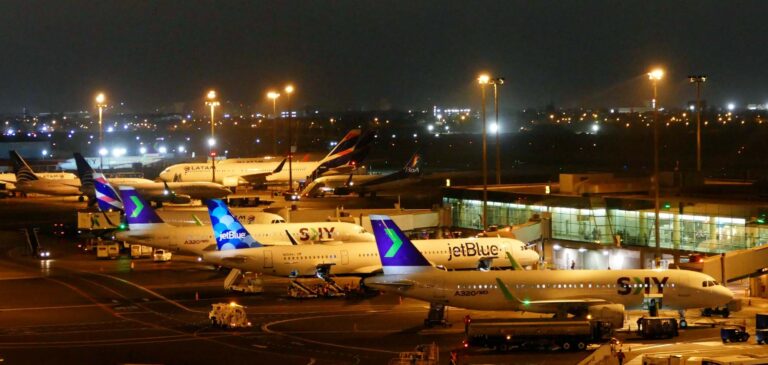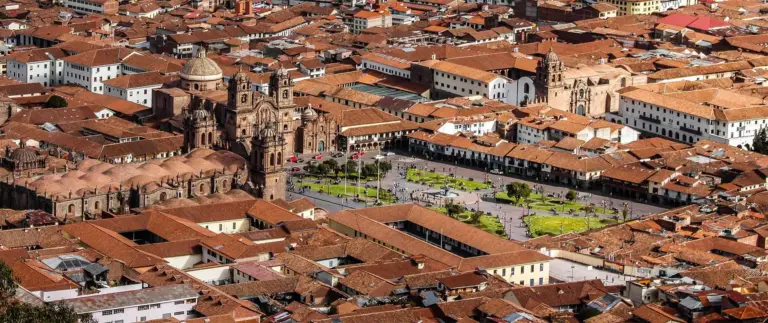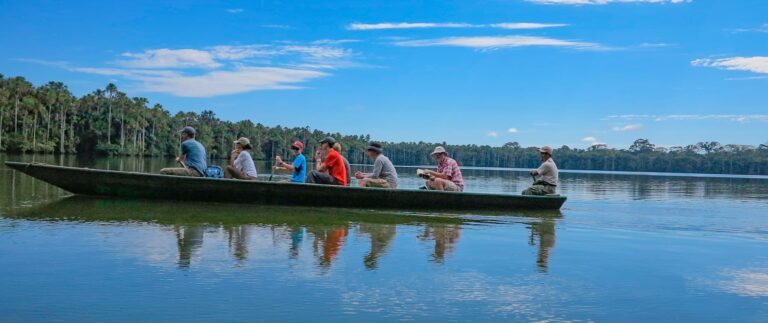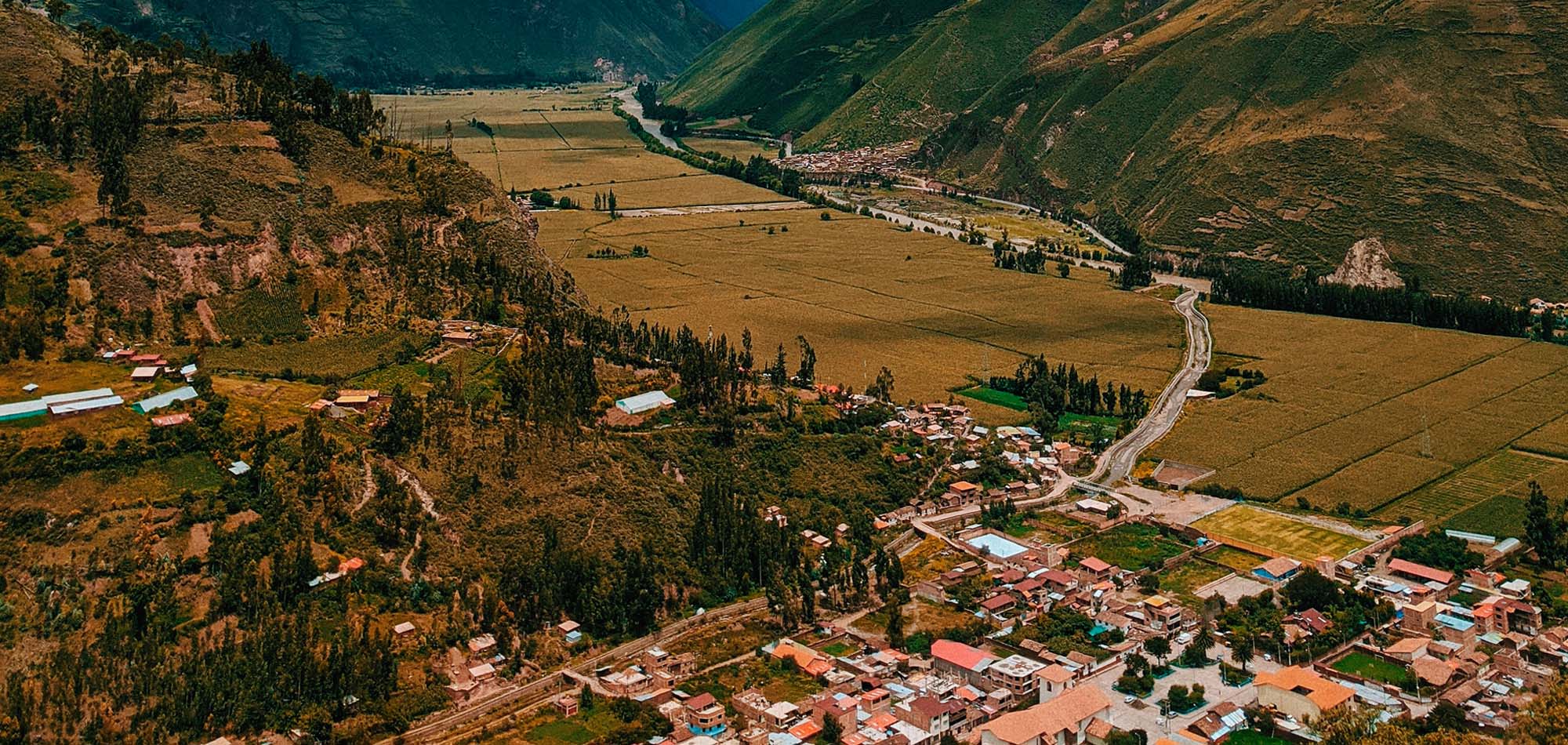
About the Sacred Valley
The Sacred Valley of the Incas also known as “Valle Sagrado” starts outside of Cusco in the town of Pisac. It extends from Pisac all the way to Ollantaytambo, nestled between Cusco and the Majestic Machu Picchu. The valley is formed by the Urubamba River also known as the Volcano River. It’s flanked by two prominent mountain peaks, Sahuasiray (height: 5 818m/ 19 088ft) in Calca and Veronica Mountain (height: 5893m/ 19 334ft) in Ollantaytambo.
This Valley was the center of Tahuantinsuyo, the largest known empire in the Western Hemisphere, from Colombia and Ecuador, passing through Peru and Bolivia, to the northern part of the nations of Argentina and Chile; and its capital is the city of Cusco, which was known as the “navel of the world.” The sacred valley has always been an agricultural hub and still remains so.
Its place and climate create the perfect spot for cultivation. The lower parts of the valley are warm and the top of the hills are cooler, making the ideal spot to keep the crops they have a regular supply of water from the many streams that flow into the valley from melting ice from the surrounding mountain peaks.
Agriculture
The Sacred Valley of the Incas has a moderate climate and fertile land, which is great for agriculture in the region. They produce maize, fruits, and vegetables for exporting and self consumption. This product is usually sold in their many local markets, which are insanely cheap with a variety of fresh fruits and vegetables. The Incas grew potatoes, white corn, coca, and fruits, on terraces like those that can be seen decorating the mountainsides throughout the villages. Today the valley gives lucuma, peach, avocado, and one of the best corn varieties in the world.
Religion and Cosmology
But it was more than just an important agricultural center; The Urubamba River Valley, “Willcamayu” for the Incas, was one of the most important elements in the religious cosmology of the Incas. They believed that the flow of the Urubamba was closely linked to constellations and mountains, they also believed that it was the counterpart of the Milky Way on Earth.
Tourism today
This region is the center of experiential tourism because of the many indigenous small towns you find along the way to Machu Picchu. You get to immerse yourself in their way of life and also visit long-standing, ancient, and historical Inca sites. It is regarded as the epicenter of adventure tourism, with many types of extreme sports to partake in. The best towns to visit include Chinchero, Pisac, Calca, Urubamba, Salinas, Moray, and Ollantaytambo. It’s the gateway to Machu Picchu, the most visited archeological site in the world.
Weather in the Sacred Valley
The Sacred Valley of the Incas is 2,800mt., 600 meters below Cusco, and enjoys one of the best climates in this region, daytime temperatures vary between 19 ° and 24 ° C. This advantageous climate made the Incas use it as their main center of agricultural production, experimentation, and research. Nowadays, travelers use the valley to acclimatize themselves, before starting their tours from Cusco through to Machu Picchu. Without a doubt, it is one of the best ways to avoid altitude sickness.
Where is the Sacred Valley of the Incas?
The Urubamba River valley or “Sacred Valley of the Incas”, is located 15 km northeast of the city of Cusco and is reachable by a paved road. A trip by car to one of the nearest villages will take around 40 minutes. From there you can move to the other villages in the valley by local vehicle or you can book a classic Sacred Valley Tour, which will take you to all the main parts of the valley.
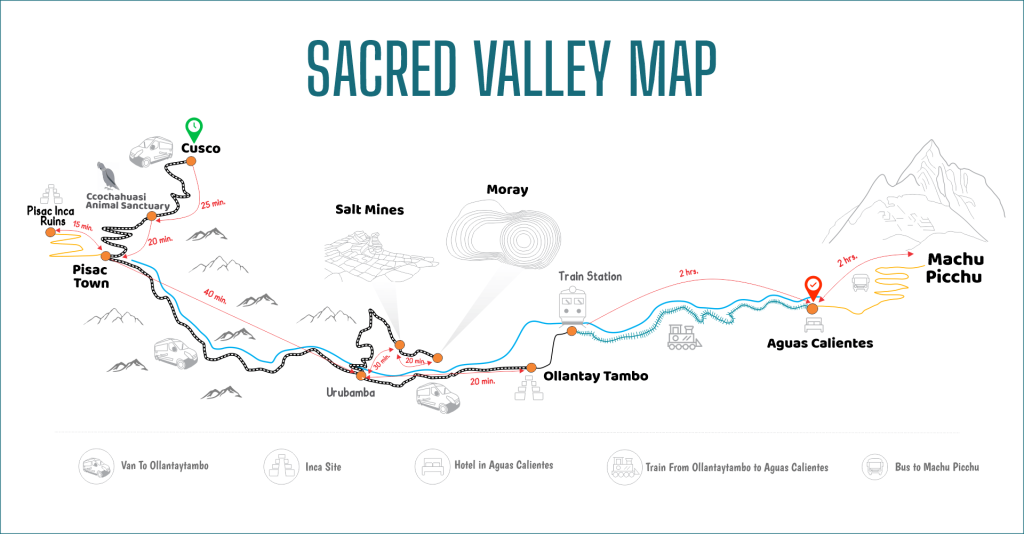
The best Sacred Valley Tour itinerary inclusions.
Sacred Valley of the Incas Tour with Moray & the Salt Mines
The tour guide should pick you up at your hotel at 7:30 am, with a private van and head towards the Sacred Valley of the Incas.
Manos de la comunidada
Manos de la Comunidad has a variety of Camelids indigenous to Peru like the llama, alpaca, guanacos, and Vicuna that give very fine wool and can only be shorn every three years. We visit this farm to pet, feed, and take photos of these animals. Also, in the center are local women dressed in local garments, weaving items using the wool from these animals. As you exit, you will encounter a museum and souvenir shop. The workers are always around to answer any queries, but you never feel pressurized to buy anything.
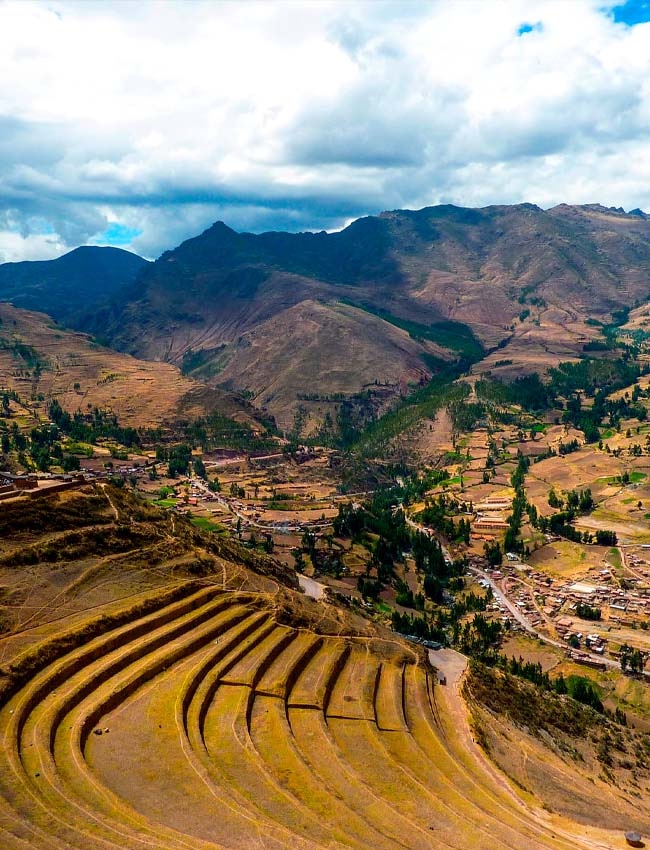
Pisac
Most agencies stop first at the Mirador of Taray, where you get your first view of the valley. This amazing view of the Urubamba Valley is laid out before you, with traditional farming communities on the valley floor and cliff peaks rising from the end of the valley. Keep reading to see the places you’ll want to visit!
You will visit the extensive and well preserved Pisac archaeological site which overlooks the green lush valley and is the entry point to the valley. The Sacred Valley was agriculturally important to the Incas and still plays a major role in the sustenance of the Cusco region. Evidence of this can be found at the site in the many food warehouse at the top of the hill, that were used for preservation because of the lower temperatures.
The lower you go, you find carefully engineered large farming terraces, taking advantage of the various microclimates. Also, the present is an intricate water irrigation system originating from the stream uphill and supplying all the decks below using water channels. Adjacent to the site is the biggest Inca cemetery found so far, with thousands of opening decorating the main side. It is said that if you visit these tombs, you can still find human skeletal remains.
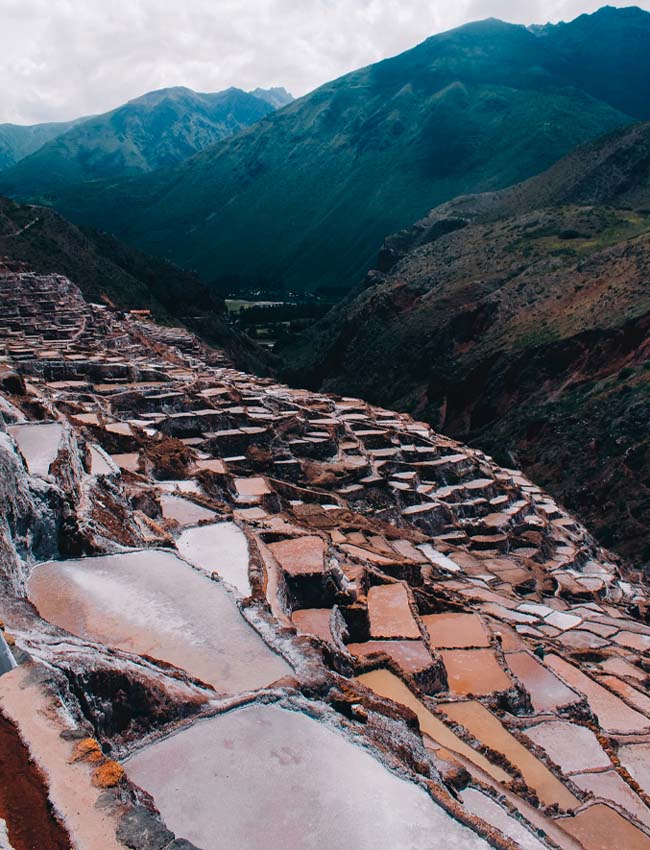
Salt mines
The Salt Mine (Salineras), close to the colonial town of Maras, is Pre-Inca. Hundreds of saltpans decorate the hillside and have been used for salt extraction since before the Inca era. A natural spring at the top of the valley discharges a small stream of water heavily laden with salt, which is diverted into saltpans and evaporated to produce salt that is of very high quality. This is one of the few places in the world where you can find naturally pink salt! The locals have full mining rights and all the salt sold on-site belongs to the locals. It still supplies Peru with over 90% of its salt. A great place to grab another souvenir.
The salt mines give you a taste of an age-old custom, that has not changed for many generations. The people in this community have been harvesting salt for many years. It’s a rich custom that has passed saltpans from one generation to the next. This has been their main source of income and they have exclusive rights to these mines.
Salineras are one of the very few salt mines left in the world to have not switched to more modern techniques. The communal company of Maras (cooperative) packages and distributes the salt and splits the profits with the families according to the number of saltpans they own. A great place to grab another souvenir.
Moray
Moray was an experimental farming site built in the form of an amphitheater with different temperatures at each level which grows different types of crops. It is sometimes referred to as the ¨Greenhouse of the Incas¨ because it functioned the same way a modern greenhouse would function. These levels of decks were carved before the Incas took control of the Sacred Valley and then used by the Incas to research optimal growing conditions for their crops. The Incas brought in many soil samples from other regions, to enhance their research. The locals were still using it for growing their crops, until the 1970s when it was preserved and protected for tourism
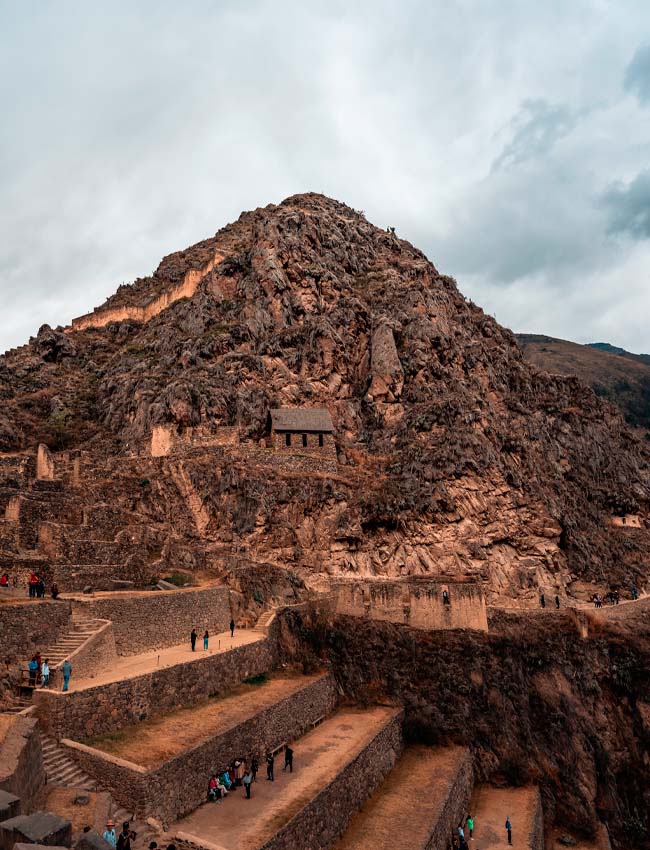
Ollantaytambo
Finally, we drive to Ollantaytambo to explore this quaint Inca village and the amazing Inca Ruins on the hilltop above. These ruins are where the Incas fought their last battle with the Spanish winners before they had to retreat and flee into the dense jungle.
Most of the structures were unfortunately incomplete. There is a section with a number of boulders that were carved but didn’t make it to their destination. Another option is that the battle was so intense, it caused a lot of damage to this massive Inca site. Still standing is the incredible architecture of the Sun Temple, admire the water fountains, the Incahuatana, and the impressive storehouses.
It is the site originally belonged to the Aymaru clan, before being taken over by the Incas, and its stands as the last and best-fought battle between the Incas and the Spanish. The Incas one this battle, but because their numbers were so depleted they fled towards the dense jungle. Most tours end here and from the top of the site, you can watch the sunset over the town and the calming river on your right.
Ollantaytambo holds many annual festivals, check online if there is anything coming up during your stay. It’s a great tourist hub, with an assortment of restaurants and accommodation establishments for all budgets. It’s the gateway to the Inca Trail or the train to Machu Picchu. Once the daily crowds spread, you are left with an amazing town, with many indigenous locals, that still call this small town home.
Additional towns
Chinchero
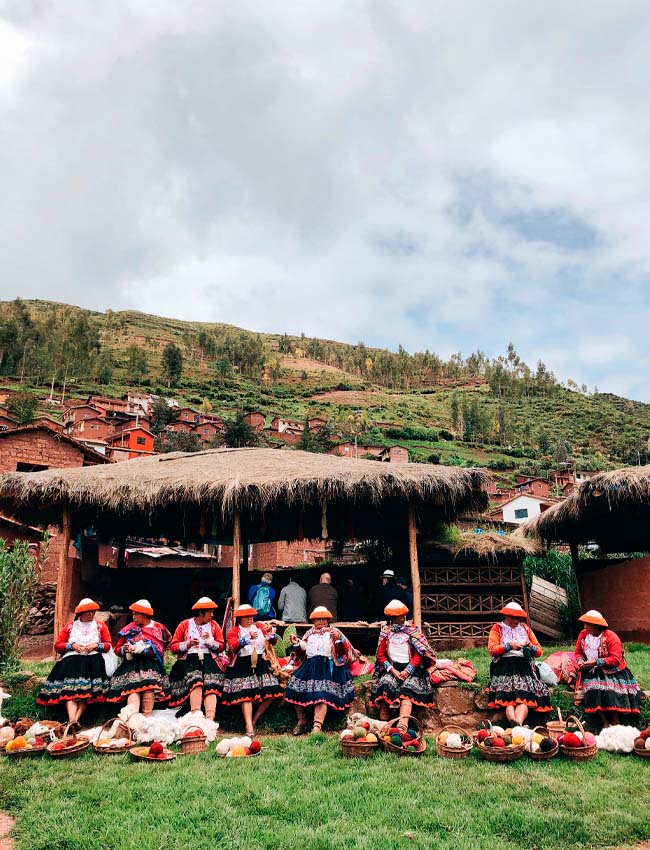
Chinchero is a small rural town between Urubamba and Cusco. It sits at a height of 3 762m/ 12 343ft. The language is predominantly spoken in Quechua (82%), however, most locals are bilingual speaking both Quechua and Spanish. An international airport is currently under construction, with its estimated completion date in 2026 (if you believe anything any government has to say). This airport is meant to serve the millions of tourists that flock in every year heading for Machu Picchu.
There are many fun and unique things to do in town. Firstly, their Sunday market is a great option for the more famous market in Pisac. It tends to be more authentic and is usually less crowded. Every weekend the streets (not that many: it’s a small town) are full of celebrations, from weddings and local concerts, playing music like Huayna. The air makes you want to dance, clap along to the beat and just let go.
Warp-face Weaving Technique
You can also learn to weave. The complementary warp-face weaving process has been practiced by the locals for centuries. The locals will teach you how they make the thread from Alpaca wool, to dyeing the fabric, and finally to making the beautiful, colorful, and clothes, the ladies and gentlemen are spotting around town. Just 3.5km out of town is Puiray Lagoon, where you can try your hand at paddle boarding. The lagoon is serene, with very few tourists around.
The most famous thing about Chinchero is the adobe colonial church found in the main plaza. This church was built upon the foundations of an Inca temple in the early 17th Century. The ceiling and walls are beautifully decorated with floral prints and religious ornaments. Some might say this church is a representation of how the Spanish managed to conquer the religious beliefs of the Incas, the main religion of Christianity. They open every Sunday for Mass free of charge.
Recommended Tour to Chinchero: Tour To Chinchero, Moray And Salt Mines Half Day
Urubamba
Urubamba is the largest town in the sacred valley. It’s a commercial center and is frequented by locals from all over the Valley for their needs. It’s central to most tours and treks around the Sacred Valley. Whether you are heading to Chinchero, Ollantaytambo, Lares Trek, or Machu Pucchu, Urubamba is an ideal place to stop for food because of its size and location. It has many restaurants with International and local fusion.
Overview
Highlights of a Sacred Valley Tour
- The amazing views of the Sacred Valley (Mirador of Taray)
- The Pisac Inca ruins, which have many impressive examples of Inca architecture
- A quick stop in Urubamba for lunch
- The Moray Archeological Site where you can learn about Incan agricultural experimentation
- The famous Pre-Inca Salt Mines of Maras where naturally salty spring water is gathered in the same way it has been for hundreds of years
- The magnificent archeological site of Ollantaytambo and amazing views of the valley
Please Note
- Not all tour operators offer the same itinerary and quality of service. Please see below for recommended tour operators.
- I did mine with Orange Nation Peru and I think they offered a great product at a fair price.
- Read the itinerary carefully before choosing an operator and making payment.
Difference between group service and private service
Group Service
- Small groups of up to 10 people, subject to availability and all the booking need to be done at least 48 hours in advance.
- The Price has ONLY the guide and vehicle, meals, and entrances are not included.
- Some companies do take groups of up to 16 people. They charge less but will include fewer stops and no personalized attention at all. If you are unfortunate enough to be at the back of the group, you won´t hear a word.
Private Service
- Private service price is based on the number of people. Private service means, ONLY your party will be on the tour, no stragglers allowed. It will be private with your own guide, driver, and private van No other person will be added to your tour.
- The Price has ONLY the guide and transportation, meals, and entrances are not included.
What to see in the Sacred Valley of the Incas?
Known by the Incas as Willcamayu, the amazing valley extends from the town of Pisac to Ollantaytambo, along the Urubamba River. The ancient Inca settlements in these cities are presented as checkpoints, before entering the “Inca Trail” that leads to the sacred city of the Incas, Machu Picchu. They are simply amazing, each one more amazing than the one before.
NOTE:
To enter into these tourist sites and attractions you need the boleto turistico.
The adventure in the Sacred Valley of the Incas
The Sacred Valley has become in recent years, one of the best places for outdoor and extreme sports. You can go cycling, hiking, climbing, paragliding, rafting, and many other extreme sports. If you are a person who enjoys adventure, the outdoors, and extreme sports, then you cannot miss this option in the Sacred Valley of the Incas.
The cultural tour of the Sacred Valley
The tour of the sacred valley will take you on a markedly traditional route, you will meet Quechua-speaking residents, with typical outfits, working their fields in an artisanal way. You will pass through villages built in the colonial period, through ancient Inca settlements. You will tour markets, temples, and city squares that will take you back to how life was like hundreds of years ago. However, to tour the main archaeological remains of the Sacred Valley, you will need to buy a tourist ticket to Cusco.
What is the Boleto Turistico?
Normally to enter tourist sites and attractions, you would expect to simply turn up and pay your entrance fee on the day, right? Well, that’s no longer the case for some of the biggest archaeological and museum attractions in Cusco and the Sacred Valley of the Incas.
Instead, the boleto turistico is a single ticket that has to be purchased in advance to allow entry to various sites, such as Sacsaywaman, the Pisac, and Ollantaytambo ruins. It is not possible to visit or enter these sites without a valid boleto turistico, and it is not likely to buy an individual entry ticket for any single site which is included on the boleto turistico.
Hotel in Ollantaytambo
If you looking for a good night’s sleep, away from crowds, covered by homes and amazing views, try Veronica View Hotel. It´s a scenic 10 m drive from Ollantaytambo, along the way, watch across the river for the original terraces from Incan times! Arriving at the hotel, you will be greeted amid gardens of native flowers and orchids. Take in the amazing sight of Veronica Mountain, covered with glaciers year-round. After you settle into your room, walk through the gardens to the pool and eatery area. There is a steam sauna, dry sauna, spa, heated swimming pool, and eatery at your feet.
Questions and answers about the Inca Sacred Valley
1) What should you visit in the Inca Sacred Valley?
The Sacred Valley of the Incas has stunning scenery, Inca archaeological sites, and Inca settlements rich in history. It is notable for the Inca sites of Pisac, Ollantaytambo, Chinchero, and Moray.
2)Where should you go for the greatest photos when visiting the Sacred Valley of the Incas? Taray and Chinchero perspectives provide two of the greatest views of the Sacred Valley of the Incas. In addition, travelers may take stunning photographs in Moray and the Maras salt mines.
3)What activities are available in the Inca Sacred Valley?
Trekking, rock climbing, ziplining, kayaking, cycling, and ATV trails are all options for visitors to the Sacred Valley of the Incas. These journeys are best taken with the assistance of a local travel oparator.
4)What should I bring on my vacation to the Sacred Valley of the Incas?
It is advised that you bring the following items with you on your journey to the Sacred Valley: sportswear, comfortable and resistant shoes, sunscreen, a hat, insect repellent, a jacket in case of rain, snacks, rehydrating drinks, and whatever else the tourist thinks necessary. Please contact your local tour operator for additional details.
5)Is it unsafe to travel to the Sacred Valley of the Incas?
It is extremely safe to travel to the Sacred Valley of the Incas. Hiring a qualified local tour guide is advised if you want to have a better hiking experience.
Recommended Tour Operators for the Sacred Valley
1. Sam Travel Peru
Over 80 trips Completed | Regional Expert Service level: top
- Small intimate groups of 2 to 8 person
- Guaranted and Secure Trips
SAM TRAVEL PERÚ is a family-owned Travel Company & Tour Operator located in Cusco, Peru that creates customized uniquely designed adventure treks and tours to untouched wilderness places, OFF THE BEATEN TRACK, in the High Andes Mountains of Peru. Our many years of experience is demonstrated in our excellent reviews!
Explore website
2. Orange Nation Peru
Over 45 trips Completed | Regional Expert Service level: Standard
- Small intimate groups of 2 to 8 person
- Guaranted and Secure Trips
ORANGE NATION is Peruvian owned Travel Company that specializes in tour and trekking in Cusco Peru. They are experienced in offering small group personalized service for tours from the BREATHTAKING ANDES MOUNTAINS TO THE MAJESTIC MACHU PICCHU CITADEL. Making your experience beyond what even you could have dreamed!
Explore website
3. Spider Travel Peru
Over 45 trips Completed | Regional Expert Service level: Standard
- Small intimate groups of 2 to 8 person
- Guaranted and Secure Trips
SPIDER TRAVEL PERU is an innovative adventure travel company in Cusco Peru that offers UNPARALLELED EXPERIENCES TO UNTOUCHED WILDERNESS AREAS. Our adventure treks and tours are specific and carefully designed to cater to budget and personal needs!
Explore website
4. Glamping Peru Treks
Over 45 trips Completed | Regional Expert Service level: Luxury
- Small intimate groups of 2 to 8 person
- Guaranted and Secure Trips
Glamping Peru Treks creates treks and tours that offer unsurpassed luxury and comfort while hiking off the beaten track. All accommodations, food, and services are of the highest quality and standards. If you are looking for something UPSCALE AND LUXURIOUS while trekking or touring, this is the absolute best option for you. Do not be afraid to work with their service operators to create your dream personalized luxury trek or tour. The company group size averages 2 to 4 persons, not exceeding 8 people. If you love your privacy, be sure to ask for a private tour.
Explore website
5. 69 Explorer Peru
Over 45 trips Completed | Regional Expert Service level: basic
- Small intimate groups of 2 to 8 person
- Guaranted and Secure Trips
Welcome to 69 Explorer, a premier tour operator based in the heart of Cusco, Peru. As a company born and nurtured in the lap of the Andes, we specialize in creating unforgettable travel experiences in one of the world’s most enchanting destinations.
Explore website